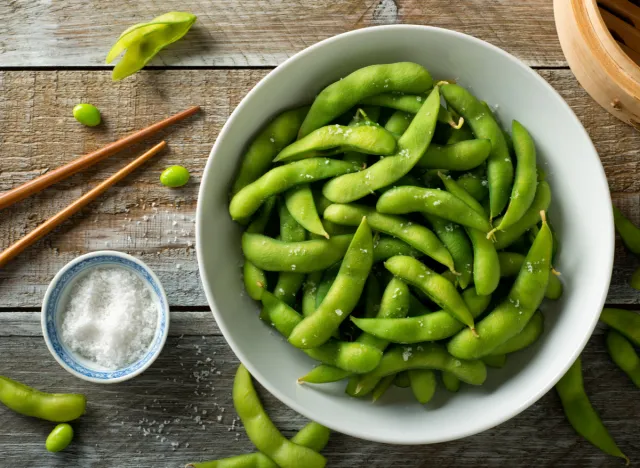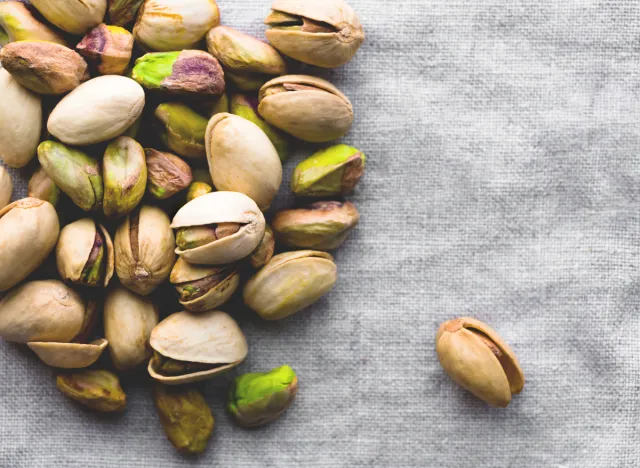12 Best High-Protein, High-Fiber Foods You Can Eat

Striking the right balance of nutrients in your diet is essential to feeling your best. This is especially true for protein and fiber, two vital nutrients crucial for good health. Whole foods rich in fiber and protein offer no shortage of health benefits, from aiding digestion and boosting immune function to improving gut health and supporting muscle growth.
But with plenty of misinformation out there, it can be challenging to know which high-protein, high-fiber foods are best for your health and well-being. To help us sift through the online noise, we spoke with registered dietitians who revealed the best high-protein, high-fiber foods.
Protein is often called the building block of life, and for good reason. This macronutrient is essential for tissue repair and healing, building muscle, and supporting a healthy immune system. Fiber is crucial for digestive health, regulating blood sugar levels, and reducing chronic disease risk. Both protein and fiber are excellent for increasing satiety, meaning they can keep you feeling fuller longer and help curb cravings and overeating.
Whether you want to improve your gut health, manage your weight, or feel more energized throughout the day, eating these high-protein, high-fiber foods can help you achieve your health and fitness goals. Read on to learn more, and then don’t miss The 16 Healthiest Low-Sugar Protein Bars, According to Dietitians.
Black Beans

Black beans are a versatile legume that can be made into burger patties or added to burritos, stir-fries, soups, and salads. A lesser-known benefit of black beans is their antioxidant content, which can help reduce the risk of chronic diseases like cancer and heart disease.
Gianna Masi, CPT, RDN, a certified personal trainer and registered dietitian with Barbend, says, “Black beans are a powerhouse of protein and fiber, making them excellent for heart health and digestion. Their low glycemic index makes them not only versatile but also beneficial for stabilizing blood sugar levels.”
Lentils

Lentils are high in soluble fiber, which feeds the beneficial bacteria in your gut. This can help improve digestion, reduce bloating, and boost gut health. “Lentils are over 25 percent protein and packed with nutrients including B vitamins, particularly folate, along with copper, manganese, and iron,” says Destini Moody, RDN, CSSD, LD, a registered dietitian and sports dietitian with Garage Gym Reviews. “One cup of cooked lentils provides nearly half your daily fiber needs. They’re also a versatile food as they can be made into vegan, Greek-style salads, added to a greens salad, or made into various soups.”
Barley

“Barley is a nutritious whole grain that offers soluble and insoluble fiber, which can help lower cholesterol and promote a healthy digestive system. Its chewy texture and nutty flavor make it a great addition to soups, stews, and salads. Barley can also be used as a healthier substitute for rice in dishes like risotto or pilaf, adding a unique twist while boosting nutritional content,” Masi explains.
Edamame

Edamame are young soybeans still in the pod. According to research, they’re an excellent source of isoflavones, an antioxidant that may help reduce the risk of certain cancers. “Edamame are not only a fun snack high in protein and fiber but are also rich in vitamins and minerals, including vitamin K and folate,” Moody explains. “Edamame can be enjoyed boiled or steamed with a pinch of salt, added to salads, or incorporated into stir-fries.”
Oats

Oats contain beta-glucans, a soluble fiber that can help lower cholesterol levels. “Oats are unique in that they contain not one, but two types of fiber: soluble and insoluble. Both types play their role. This includes helping to improve blood sugar control, support healthy digestion, and regulate appetite. You can use raw, rolled oats to make snacks like protein bites or add them to smoothies for texture, fiber, and a boost in calories if you’re trying to gain some muscle,” Moody says.
Almonds

“A great snack to have in your car, at your desk, or on a long hike, almonds are a wonderful (and portable) source of fiber and protein,” Moody says. “Just one ounce provides half your daily vitamin E needs, an important antioxidant. You can have almonds on their own or as a topping to smoothie bowls and oatmeal.” Studies suggest that vitamin E can boost your skin health by helping maintain healthy skin cells and protecting against skin damage and aging.
Flaxseed

Flaxseeds are an excellent source of protein, fiber, and omega-3 fatty acids. The type of omega-3 in flaxseed is called alpha-linolenic acid (ALA), which can help reduce heart disease risk. “These tiny seeds are easy to incorporate into your diet. You can add ground flaxseeds to smoothies, yogurts, and baked goods like muffins and bread, or use them as a crunchy topping for salads and cereals,” Masi says.
Quinoa

Quinoa is unique because it’s a complete plant-based protein source, meaning it contains all nine essential amino acids required for optimal health. “Quinoa is rich in nutrients like manganese, magnesium, and phosphorus. It’s gained popularity recently as a great vegan source of plant protein. Quinoa is classified as a whole grain but is technically a seed. This means it’s gluten-free, which is good news for those with sensitive stomachs and allergies,” Moody tells us.
Pistachios

Besides being a high-protein, high-fiber nut, pistachios may also promote eye health due to their high content of lutein and zeaxanthin, two antioxidants that support vision and reduce the risk of macular degeneration.
“Pistachios are a fantastic on-the-go snack and can enhance the flavor and nutritional profile of various dishes. Try them chopped in salads, crushed as a crust for fish or chicken, or mixed into baked goods for a nutty crunch,” Masi says.
Chia Seeds

“Chia seeds are high in omega-3s, an essential nutrient that’s good for your heart and brain health,” Moody explains. The most popular way to eat chia seeds is by making chia seed pudding, a versatile breakfast idea that can also include other nutrient-dense foods for toppings like fruit or almond butter.” Chia seeds have also been associated with lower cancer risk due to their high antioxidant content, which helps reduce inflammation.
Tempeh

Tempeh is a fermented soybean product high in protein, fiber, and probiotics, which can boost gut health. “Tempeh has a firm texture and a nutty flavor,” Masi explains. “It’s also an excellent meat substitute for vegetarians and vegans. Tempeh can be grilled, sautéed, or added to sandwiches and salads, making it a versatile and healthful addition to meals.”
Chickpeas

Chickpeas are another versatile legume high in protein and fiber. According to 2016 research, they’re also a good source of soluble fiber, which can help lower cholesterol levels and improve heart health.
“You can add chickpeas to soup and salad or use them to make curry or hummus,” Moody says. “You can also roast them and make them sweet by coating them in cinnamon and sugar before roasting, or you can make them savory by seasoning them with ranch or curry powder. Depending on your cravings, this makes for a filling snack you can enjoy day or night.”
- Source: Khalid, W., Arshad, M. S., Jabeen, A., Muhammad Anjum, F., Qaisrani, T. B., & Suleria, H. A. R. (2022). Fiber-enriched botanicals: A therapeutic tool against certain metabolic ailments. Food science & nutrition, 10(10), 3203–3218. https://doi.org/10.1002/fsn3.2920
- Source: Munteanu, C., & Schwartz, B. (2022). The relationship between nutrition and the immune system. Frontiers in nutrition, 9, 1082500. https://doi.org/10.3389/fnut.2022.1082500
- Source: Cronin, P., Joyce, S. A., O'Toole, P. W., & O'Connor, E. M. (2021). Dietary Fibre Modulates the Gut Microbiota. Nutrients, 13(5), 1655. https://doi.org/10.3390/nu13051655
- Source: Stokes, T., Hector, A. J., Morton, R. W., McGlory, C., & Phillips, S. M. (2018). Recent Perspectives Regarding the Role of Dietary Protein for the Promotion of Muscle Hypertrophy with Resistance Exercise Training. Nutrients, 10(2), 180. https://doi.org/10.3390/nu10020180
- Source: Wang, X., Yu, Z., Zhou, S., Shen, S., & Chen, W. (2022). The Effect of a Compound Protein on Wound Healing and Nutritional Status. Evidence-based complementary and alternative medicine : eCAM, 2022, 4231516. https://doi.org/10.1155/2022/4231516
- Source: McRae M. P. (2018). Dietary Fiber Intake and Type 2 Diabetes Mellitus: An Umbrella Review of Meta-analyses. Journal of chiropractic medicine, 17(1), 44–53. https://doi.org/10.1016/j.jcm.2017.11.002
- Source: Fatima, I., Gamage, I., De Almeida, R. J. R., Cabandugama, P., & Kamath, G. (2023). Current Understanding of Dietary Fiber and Its Role in Chronic Diseases. Missouri medicine, 120(5), 381–388.
- Source: Sharafi, M., Alamdari, N., Wilson, M., Leidy, H. J., & Glynn, E. L. (2018). Effect of a High-Protein, High-Fiber Beverage Preload on Subjective Appetite Ratings and Subsequent Ad Libitum Energy Intake in Overweight Men and Women: A Randomized, Double-Blind Placebo-Controlled, Crossover Study. Current developments in nutrition, 2(6), nzy022. https://doi.org/10.1093/cdn/nzy022
- Source: Mullins, A. P., & Arjmandi, B. H. (2021). Health Benefits of Plant-Based Nutrition: Focus on Beans in Cardiometabolic Diseases. Nutrients, 13(2), 519. https://doi.org/10.3390/nu13020519
- Source: Kadyan, S., Sharma, A., Arjmandi, B. H., Singh, P., & Nagpal, R. (2022). Prebiotic Potential of Dietary Beans and Pulses and Their Resistant Starch for Aging-Associated Gut and Metabolic Health. Nutrients, 14(9), 1726. https://doi.org/10.3390/nu14091726
- Source: Fan, Y., Wang, M., Li, Z., Jiang, H., Shi, J., Shi, X., Liu, S., Zhao, J., Kong, L., Zhang, W., & Ma, L. (2022). Intake of Soy, Soy Isoflavones and Soy Protein and Risk of Cancer Incidence and Mortality. Frontiers in nutrition, 9, 847421. https://doi.org/10.3389/fnut.2022.847421
- Source: Joyce, S. A., Kamil, A., Fleige, L., & Gahan, C. G. M. (2019). The Cholesterol-Lowering Effect of Oats and Oat Beta Glucan: Modes of Action and Potential Role of Bile Acids and the Microbiome. Frontiers in nutrition, 6, 171. https://doi.org/10.3389/fnut.2019.00171
- Source: Liu, X., Yang, G., Luo, M., Lan, Q., Shi, X., Deng, H., Wang, N., Xu, X., & Zhang, C. (2021). Serum vitamin E levels and chronic inflammatory skin diseases: A systematic review and meta-analysis. PloS one, 16(12), e0261259. https://doi.org/10.1371/journal.pone.0261259
- Source: Office of Dietary Supplements - Omega-3 fatty acids. (n.d.-b). https://ods.od.nih.gov/factsheets/Omega3FattyAcids-Consumer/
- Source: Craine, E. B., & Murphy, K. M. (2020). Seed Composition and Amino Acid Profiles for Quinoa Grown in Washington State. Frontiers in nutrition, 7, 126. https://doi.org/10.3389/fnut.2020.00126
- Source: Mandalari, G., Barreca, D., Gervasi, T., Roussell, M. A., Klein, B., Feeney, M. J., & Carughi, A. (2021). Pistachio Nuts (Pistacia vera L.): Production, Nutrients, Bioactives and Novel Health Effects. Plants (Basel, Switzerland), 11(1), 18. https://doi.org/10.3390/plants11010018
- Source: Khalid, W., Arshad, M. S., Aziz, A., Rahim, M. A., Qaisrani, T. B., Afzal, F., Ali, A., Ranjha, M. M. A. N., Khalid, M. Z., & Anjum, F. M. (2022). Chia seeds (Salvia hispanica L.): A therapeutic weapon in metabolic disorders. Food science & nutrition, 11(1), 3–16. https://doi.org/10.1002/fsn3.3035
- Source: Subali, D., Christos, R. E., Givianty, V. T., Ranti, A. V., Kartawidjajaputra, F., Antono, L., Dijaya, R., Taslim, N. A., Rizzo, G., & Nurkolis, F. (2023). Soy-Based Tempeh Rich in Paraprobiotics Properties as Functional Sports Food: More Than a Protein Source. Nutrients, 15(11), 2599. https://doi.org/10.3390/nu15112599
- Source: Wallace, T. C., Murray, R., & Zelman, K. M. (2016). The Nutritional Value and Health Benefits of Chickpeas and Hummus. Nutrients, 8(12), 766. https://doi.org/10.3390/nu8120766









